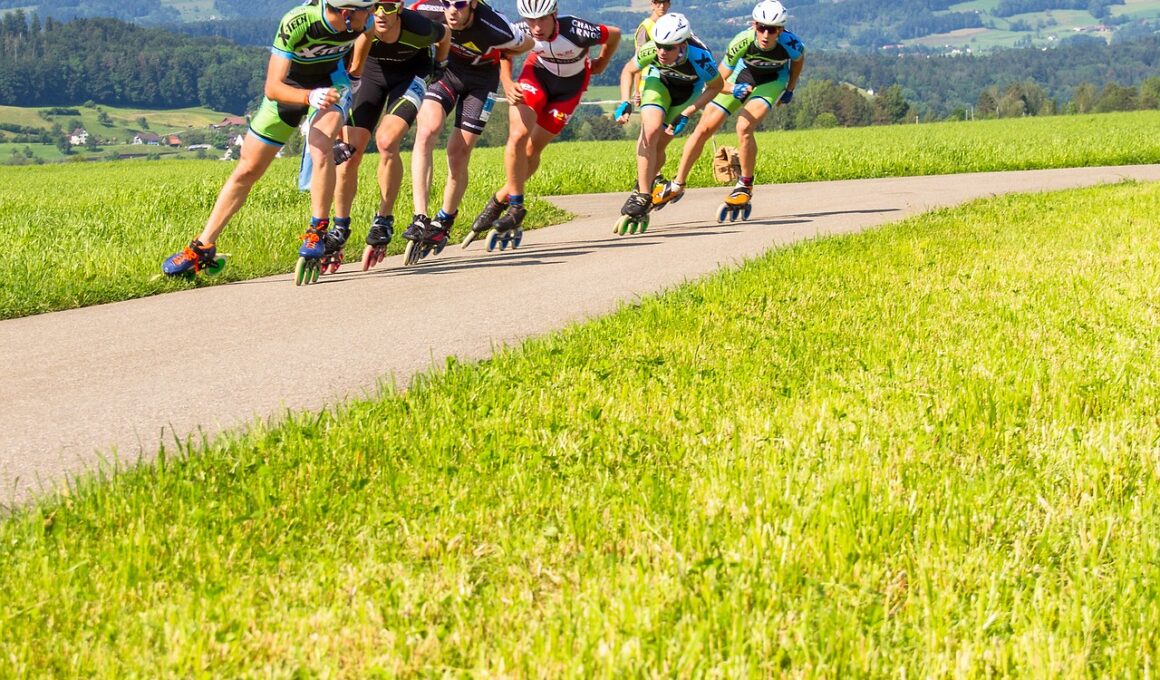Historical Perspective of Inline Skating
Inline skating, or rollerblading as it is often called, originated from a mixture of various skating styles. The first verified instances date back to the late 1700s when individuals experimented with wooden, wheeled contraptions for recreational and training purposes. The modern iteration started gaining traction in the 1980s when companies began designing inline skates that closely resemble today’s models. This transformation enabled faster speeds and improved balance. Notably, inline skates use a single row of wheels, which offers enhanced maneuverability compared to traditional quad skates. Pioneering companies such as Rollerblade brought innovative technologies into production, marking an era that emphasized performance and safety in skating. As the popularity surged, professional skating emerged, featuring events such as inline hockey and aggressive skating. These developments reflected broader cultural trends in sports and recreation, intertwining with skateboarding culture, which grew in parallel. The introduction of inline skating competitions further cemented its status in the sports community, showcasing daring tricks and athletic prowess. Today, inline skating boasts a rich history and community, maintaining its importance alongside skateboarding in action sports.
Origins of Skateboarding
Skateboarding emerged in the late 1940s and early 1950s as a response to surfers wanting to practice their maneuvers on land when the waves were calm. Initially called “sidewalk surfing,” it involved attaching wheels to a wooden board, providing an alternative for thrill-seekers. The early boards were often homemade and lacked the sophistication of contemporary models. As the sport developed, commercial skateboards began to appear, allowing for more accessibility and diversity in design. The 1960s witnessed an explosion in popularity, with manufacturers producing boards aimed at specific tricks and styles. Along with this growth, the invention of the first skateboard-specific wheels optimized performance. Skateboarding gained traction in popular culture, with the rise of competitions and sponsorships for top skaters. Skate parks emerged in the 1970s, offering dedicated spaces for enthusiasts to practice and showcase their skills. Innovations, such as the kicktail and improved materials, transitioned skateboarding into a fully recognized sport. By the 1980s, skateboarding was firmly established in both youth culture and mainstream media, signifying its evolution from simple pastime to action sport.
The impact of skateboarding and inline skating on youth culture has been profound, as they signify freedom, creativity, and the pursuit of adrenaline. Over the decades, each sport has developed its unique identity, yet they often intersect. Youth involvement in these activities promotes physical fitness and skill development, encouraging a sense of community among participants. Skateboarding, with its rich history of creativity in tricks, has inspired films, music, and art, fostering a vibrant cultural hub. Inline skating, while sometimes overshadowed, has also made significant contributions to sporting events like the X Games, showcasing breathtaking performances and innovative techniques. Many skaters and bladers form crews, encouraging collaboration and competition alike. The emergence of social media further revolutionized their cultural significance, allowing athletes to share their talents globally. Events such as local competitions or street skating sessions bring tight-knit communities together, cultivating friendships and fostering mutual support. By emphasizing inclusivity and diversity, both sports reflect broader societal themes and serve as conduits for self-expression. They remain not only sports but also cultural phenomena, influencing countless lives across generations.
Comparative Evolution of Skills
Skills in skateboarding and inline skating have evolved concurrently but diverged in execution. Skateboarders often focus on tricks that revolve around the board’s shape, utilizing its edge to perform grinds, slides, and flips. The kicktail design of skateboards allows for a myriad of stunts, enabling skaters to display exceptional agility and creativity. Inline skaters, on the other hand, emphasize speed and fluidity, attracting attention with their aerial tricks and edge work on ramps. Each discipline requires a unique set of skills developed through practice and perseverance, leading to specialized forms of performance. Skateboarding often translates to street culture, showcasing self-expression through urban landscapes. Conversely, inline skating transcends into sports arenas, evidenced in disciplines like speed skating and freeskate. Both sports embrace a competitive spirit, evident in numerous championships worldwide that celebrate talent in executing complex tricks and routines. The training methodologies and gear adopted by athletes also reflect their dedication and passion, pushing boundaries in their respective fields. Despite their differences, the interrelationship between skateboard and inline skate cultures continues to flourish, fostering mutual respect among athletes.
The cultural perceptions of skateboarding and inline skating carry distinct yet interrelated attributes that shape their identities. Skateboarding has long been associated with rebellious youth culture, often depicted in media highlights like films and documentaries that showcase its rich subculture. This edge has solidified skateboarding’s status as a symbol of freedom and individuality. Conversely, inline skating has historically been perceived as a more mainstream and organized sport. As a result, its image differs, often featuring athletes as part of Olympic and competitive events. Despite these perceptions, both sports collide at individual levels, where participants embrace shared values of creativity, community, and sport. Notably, the ongoing evolution of both disciplines is evident in emerging hybrid styles—trick combinations that showcase elements from both sports. Events and competitions increasingly welcome participants of all kinds, fostering an inclusive environment that emphasizes collaboration over competition. Additionally, consumers have witnessed a surge in dual-interest gear and apparel, indicating the merging of these cultures. As both skateboarding and inline skating continue to evolve, they reshape their relationship through shared experiences and a collective love for riding.
Modern Challenges and Opportunities
In the modern landscape of action sports, skateboarding and inline skating face both challenges and opportunities. As both activities grow in popularity, they encounter evolving perceptions and competition from new sports such as parkour and electric scooters. Urban infrastructure participating in extreme sports has also improved, leading to increased access to skate parks and improved safety guidelines. However, skaters and bladers alike also navigate issues related to space, as urbanization and gentrification can threaten dedicated areas. There are concerns about maintaining community integrity while attracting new enthusiasts who might not share the same ethos. Collaborations between cities and organized sports bodies can facilitate the development of inclusive environments that support both skateboarding and inline skating communities. Additionally, the integration of technology has made it easier for practitioners to connect, share experiences, and promote their skills through social media platforms. By embracing these challenges, athletes and organizations can cultivate a vibrant future for both sports, continuing their legacies and expanding their reach. Overcoming obstacles will require unity among participants to push forward together.
Historically, inline skating and skateboarding have steadily evolved, expanding their distinct yet intertwined paths. The comparison of their histories reveals the growth of both sports, complementing each other while standing out in unique ways. Inline skating originated as a functional adaptation, while skateboarding arose from a culture seeking land use during calm waves. Both carry ingrained traditions that have shaped their respective identities and are mirrored in community interaction. Additionally, sport representation on global platforms opens avenues for wider acceptance and recognition. The two have evolved separately but together, with mutual respect and enthusiasm permeating their cultures. The opportunities for collaboration and innovation continue to flourish, promoting shared values of creativity and community. Although distinct today, the connection between skating and blading emphasizes the importance of appreciation for one another’s developments. The future of both inline skating and skateboarding rests on building communities, providing opportunities, and celebrating diversity among athletes. This duality ensures that the legacies of these sports are preserved and celebrated, enriching the culture of action sports overall. With a collective effort, both sports can thrive as powerful modes of expression and athleticism.


